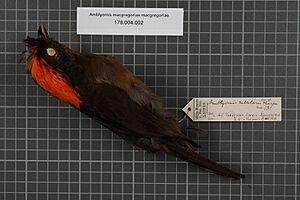MacGregor's bowerbird facts for kids
Quick facts for kids MacGregor's bowerbird |
|
|---|---|
 |
|
| Male specimen at the Naturalis Biodiversity Center. | |
| Conservation status | |
| Scientific classification | |
| Genus: |
Amblyornis
|
| Species: |
macgregoriae
|
| Synonyms | |
|
Loria mariae |
|
The MacGregor's bowerbird (Amblyornis macgregoriae) is a cool bird found in the mountain forests of New Guinea. It's about 26 centimeters (10 inches) long, which is similar in size to a robin. This bird is mostly olive-brown.
What makes the male MacGregor's bowerbird special is its bright orange-yellow crest. This crest can stand up straight, but the bird usually keeps it hidden. The female looks similar but does not have this colorful crest.
Contents
Amazing Mimics
MacGregor's bowerbirds are fantastic at copying sounds. They can imitate other birds, pigs, and even the sound of rushing water. Sometimes, they can even copy human speech!
Building a Special Home
The male bowerbird builds a unique structure called a "bower" to attract females. It's like a tower made of twigs, with a central pole. Around this pole, there's a dish-shaped area made of moss with raised walls. This whole structure can be about 1 meter (3 feet) wide.
The male decorates his bower with all sorts of things. He uses colorful flowers, tasty fruits, interesting insects, and other objects he finds.
Courtship and Reproduction
When a female comes near his bower, the male puts on a show. He struts around and calls out loudly. He also raises his bright crest to show off its full color. Keeping the crest hidden most of the time helps protect him from predators. He only shows it when he wants to impress a female.
The male bowerbird tries to attract many females with his amazing bower and display.
What They Eat
MacGregor's bowerbirds mostly eat fruits and insects. They find these foods in their forest home.
Conservation Status
Good news! The MacGregor's bowerbird is quite common where it lives. Because of this, it is listed as "Least Concern" on the IUCN Red List. This means it is not currently in danger of disappearing.
How It Got Its Name
This bird was named after 'Lady Macgregor'. She was the wife of Sir William MacGregor. Sir William was in charge of British New Guinea from 1888 to 1898.


